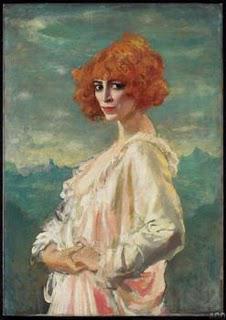
Back in the 80s when I used to visit the Art Gallery of Ontario, one of my favourite paintings to see was the Marchesa Casati; a fiery red head with a smoldering gaze. Painted by Augustus John, the Marchesa was largely a mystery to me. This was in the pre-internet days.
Fast forward to the early 90s and the day when I took my love to see my favourite painting. It was gone. I was momentarily deflated but the intelligent people at the AGO had launched a retrospective on the Marchesa Casati that very week and just a few feet away was all the information I could absorb about the naughty lady in her negligee.
The Marchesa was born into a rich Italian family in 1881. The early deaths of her parents made Luisa and her elder sister the wealthiest heiresses in Italy and then she into married an equally rich family. She was a women born ahead of her time who probably never should have married. Predictably, when the shackles of marriage had begun to frustrate her, Luisa began an affair - with poet and dramatist Gabriele D’Annunzio as her subject.
She began to live an extravagant and eccentric lifestyle, living separately from her husband and throwing the most elaborate parties money could buy. This society girl of the early 1900s became the most notorious celebrity of her circle. She was as free and bohemian as a 21st Century party girl; except she was very rich. Gilded nude servants waited at her table. She wore live snakes as jewelry and walked through Paris with cheetahs on diamond studded leashes.
She became the muse of many painters and photographers, leaving many lovers in her wake. Augustus John, painter of the portrait I was so enamoured with, was one of them. He is credited with saying, “Luisa Casati should be shot, stuffed and displayed in a glass case."
Besides Augustus John, Luisa Casati was painted by Giovanni Boldini, Kees Van Dongen, Romaine Brooks; sculpted by Giacomo Balla, and Jacob Epstein; and photographed by Man Ray and Cecil Beaton. More than 130 images of her would be completed before she became destitute.
She had an amazing rose-coloured marble palazzo that lay just outside Paris featuring a a private art gallery where she herself was the star attraction. At the her Villa San Michele on the Isle of Capri, she partied with the likes of Jean Cocteau, Serge Diaghilev, and the Art Deco painter, Tamara de Lempicka.
At one of her later and more extravagant parties she wore a costume covered with electric lights. She blew the fuses.
Though the masquerades and the commissions seemed endless, Luisa's fortunes were not. Little by little her money ran out. By 1930, Casati had amassed a debt of twenty-five million U.S. dollars. She ended her days in London where she was rumoured to be seen rummaging in bins searching for feathers to decorate her hair She died in 1957 in her London bed-sit.
Several years ago, Augustus John's 1919 painting of Casati was voted the most popular work in the Art Gallery of Ontario, Toronto. My husband found a poster of the beloved picture in a bin for $2.00. $200 worth of framing later the picture hangs in my hall.
I bought the book Infinite Variety: The Life and Legend of the Marchesa, by by Scot D. Ryersson and Michael Orlando Yaccarino when it first came out in 1999. If I’ve piqued your interest, the book is well worth getting your hands on. Ryersson and Yaccarino also have an incredibly lush and detailed website dedicated to their favourite subject. http://www.marchesacasati.com

